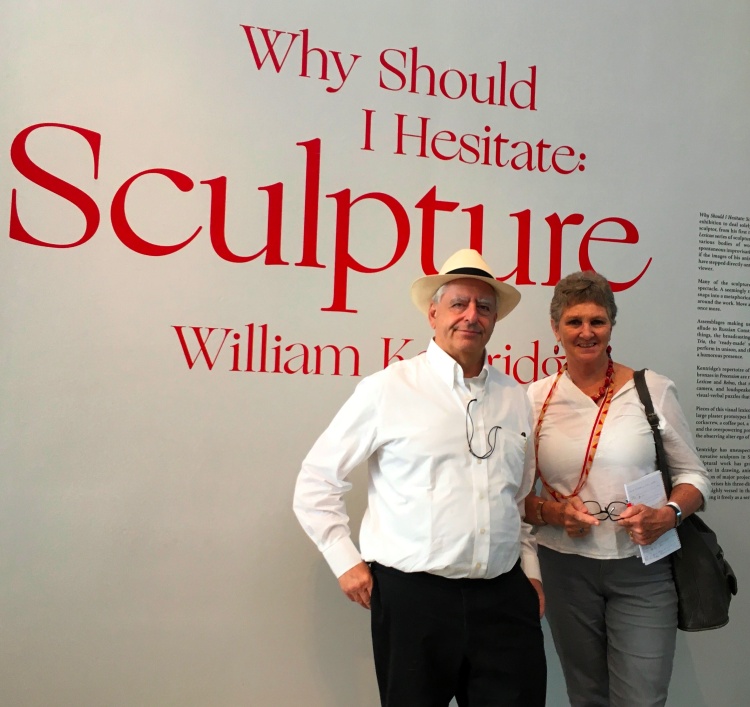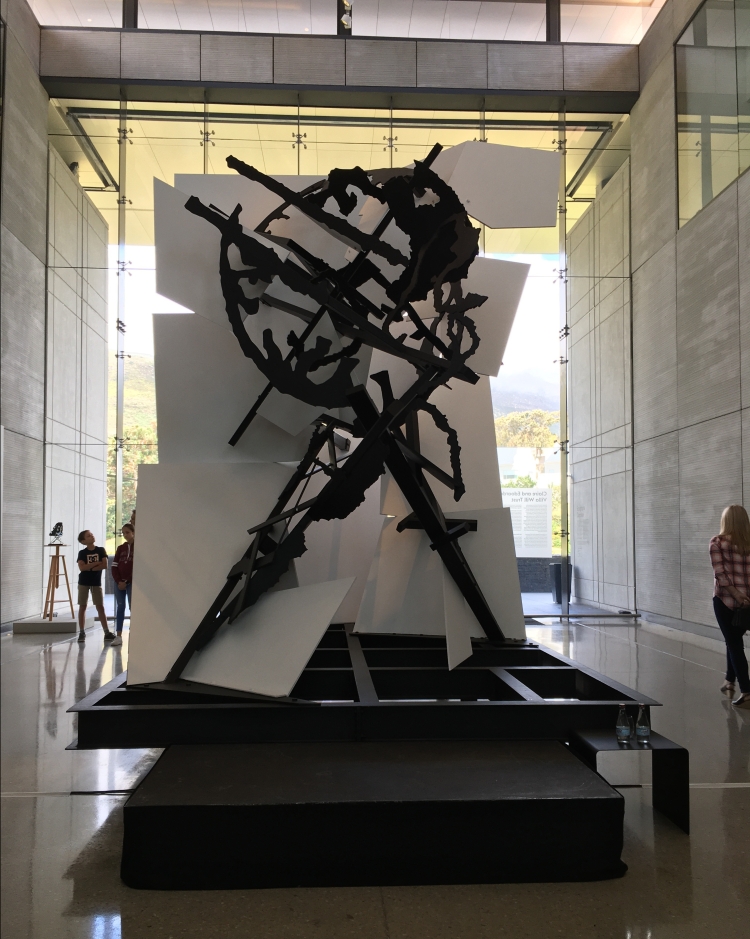On this hundred-and-so-manieth day of lockdown in South Africa (or should I maybe use a capital letter for the ‘L’-word – seeing as it has become so prominent and pronounish?), I am rummaging for something uplifting and inspiring to share. A mind-blowing art exhibition that I attended in February – before Level 5 Lockdown – comes to mind.
It was a hot summer’s day in Cape Town when we trooped into the modern, clean-lined building in Tokai, with its vast expanses of glass. Inside it was light and slightly cooler. On the one wall there was a huge poster mural with red letters drawing the attention to the theme of the exhibition we had come for: Why Should I Hesitate: Sculpture, by South African William Kentridge.

The acclaimed artist and I …
In hindsight, this theme seems somewhat prophetically appropriate for the months of lockdown that were to follow – which rudely interrupt the planned exhibition period.
Upon entering the building, one of the first exhibits I saw – stopping me in my tracks – was a larger than life metal and wood sculpture, the curved top part of which reminded vaguely of a globe … but also not. At first sight it looked as though it was mounted on a mathematical compass … but also not. I soon learned that viewing it from a certain, specific spot, rewarded you with a two-dimensional image of the globe. From other angles, in the artist’s own words it simply depicts a mess. Fascinating!

A fascinating and almost playful aspect of the viewing experience was that a seemingly random composition of abstract planes takes on a metaphorical image as you move around the artwork. Then – as you move on, it dissipates.

Why Should I Hesitate was the first exhibition internationally to address the multi-faceted Kentridge’s output as a sculptor. It placed a unique focus on this aspect of his artwork, from his first two bronzes in 1984, to his monumental Lexicon series of sculptures displayed here for the first time. It was on view at Norval from 24 August last year and was meant to run until 25 May this year. Like so many other pre-planned projects and productions, it has since 27 March obviously not been possible for anyone to visit the centre. (According to the Norval Foundation’s website, the complex will be reopening on 2 September this year.)
An exposition in words on the wall, said this: “The various bodies of work testify to his longstanding and spontaneous improvisation with three-dimensional form. It is as if the images of his animations and the props from his operas have stepped directly onto ground level, where they confront the viewer.”
You understand the unmistakable hint of playfulness when Kentridge says he used to create puppet shows for his children for each and every birthday party – until they eventually stopped him. Those props then became sculptures …
“In Singer Trio, the ‘ready-made’ sewing machines are given voices to perform in unison, and their synchronised megaphones take on a humorous presence.”
“Kentridge’s repertoire of small, familiar images from the early bronzes in Procession are reinterpreted and arrayed on shelves, in Lexicon and Rebus, that read as lines of text: horse, nose, jug, camera and loudspeaker line up, creating rebuses – those visual-verbal puzzles that so delighted the early Surrealists.
More fascinating bronze casts await: a gigantic corkscrew, a coffee pot, a flourish in the form of an ampersand, and an imposing film camera.
“Kentridge has unsuspectingly emerged as one of the most innovative sculptors in South Africa and internationally. His sculptural work has grown organically out of a sustained practice in drawing, animation, performance, opera and his direction of major projects around the world.
“The variety that characterises his three-dimensional practice is informed by his being highly versed in the language of 20th century sculpture, and using it freely as a series of dialects.”
& & & & & & & &
Information about the artist (who is, by the way, a peer! – born in the same year as I was.)
William Kentridge was born in Johannesburg, South Africa in 1955. (His parents, Sir Sydney Kentridge and Felicia Geffen, were both anti-apartheid lawyers and civil-rights activists. His father achieved international status after defending Nelson Mandela in the “Treason Trials” of 1956-61 and also for representing the family of Steve Biko, founder of the “Black Consciousness Movement”, who died in police custody in 1977.)
Kentridge is a filmmaker, draughtsman, and sculptor who is best known for his prints, drawings, and animated films. These are constructed by filming a drawing, making erasures and changes, and filming it again. He continues this process meticulously, giving each change to the drawing a quarter of a second to two seconds’ screen time. A single drawing will be altered and filmed this way until the end of a scene. These drawings are later displayed along with the films as finished pieces of art.
After studying politics and African history at the University of Witwatersrand in Johannesburg from 1973 until 1976, Kentridge studied Fine Art at the Johannesburg Art Foundation (1976–1978) and the École Jacques Lecoq in Paris. His interest in theatre —specifically in acting and design—influenced his artistic style and inspired a desire to connect film and drawing. Kentridge’s drawings, usually rendered using pastels and charcoal, were often created as studies for animated films.
ARTWORKS
The central focus of Kentridge’s oeuvre has been to examine the years before and after apartheid. The artist conflates his autobiography with that of fictionalized characters to relate his narratives, rendering his signature expressive, gestural drawings in black charcoal and ink. “My work is about the provisionality of the moment,” the artist has said of his practice. Kentridge gained international acclaim for his short film series 9 Drawings for Projection (1989–2003). In 2016, his solo exhibition “Thick Time” opened at White Chapel Gallery in London to critical acclaim, evoking 1920s-era technology and Dadaist collage. Kentridge has also directed several operas, most notably the 2017 production Wozzeck. The artist continues to live and work in Johannesburg, South Africa. Kentridge’s works are held in the collections The Museum of Modern Art in New York, the Art Institute of Chicago, the Tate Gallery in London, and the Goetz Collection in Munich, among others.







Great article, Lisel!
Dankie Wilma.
As jy nie die video’tjie kon bekyk nie, probeer asb. weer – dis nogal ‘intriguing’.
Art is in the eye of the beholder! Interesting!
Hi Gina – how sweet of you to ‘pop in’! Especially during these very strange times. It takes my thoughts back to Miguel’s delightful haven in Porto, where we had the privilege of sharing space with you and your husband…
Hallo woordkunstenaar – interessant! Vergun my iets oor die uitstallingstema. Die Pes het huiwering gebring. Onsekerheid oor die toekoms het ons as’tware tot stilstand gebring. Aanbeweeg sal ons moet. Mooi loop.
Fascinating! A very important aspect of art is appreciation or making time to visit exhibitions like this. This provides the air or energy for artists to create more and more. Well done, William and Lisel.
Pingback: Drawing for Sobriety, Obesity & Growing Old by William Kentridge